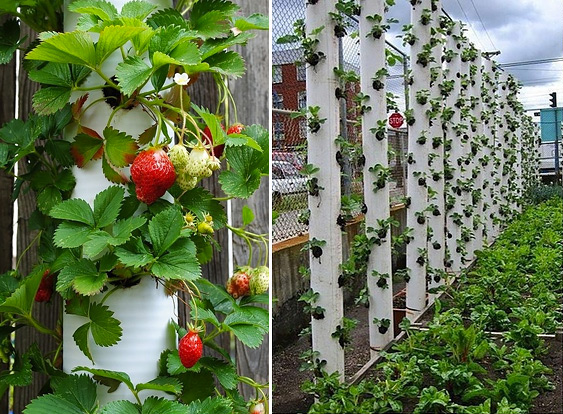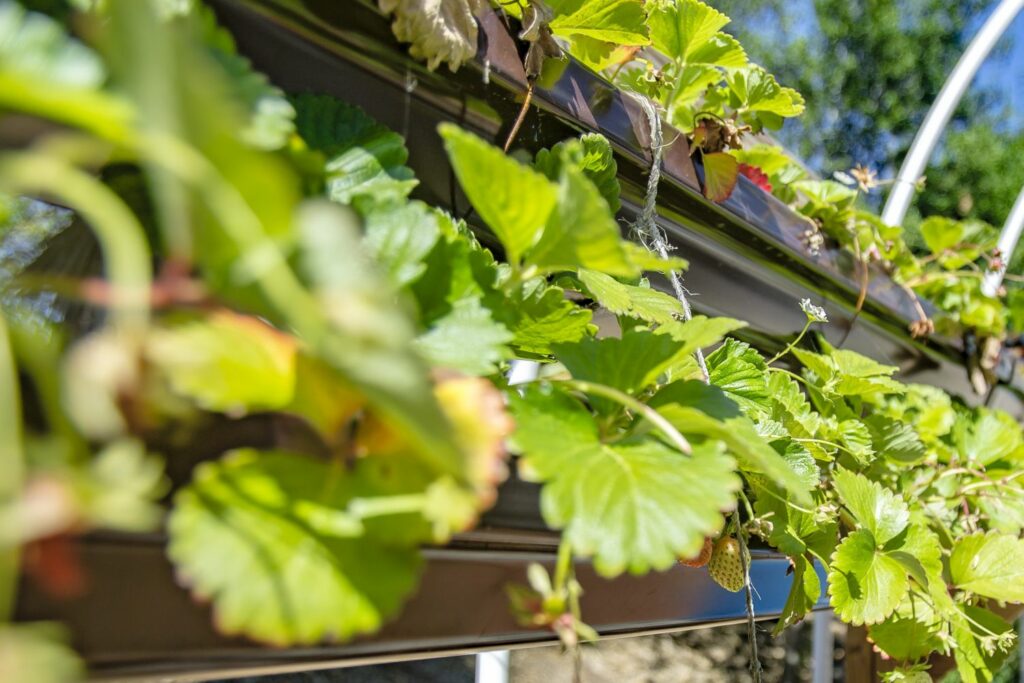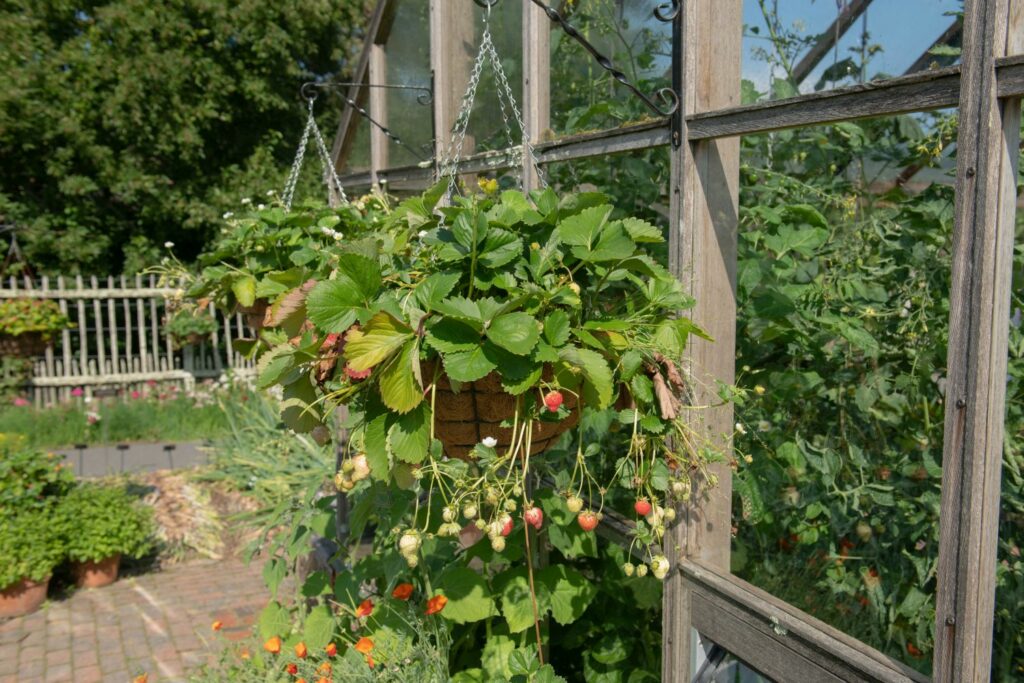Growing strawberries vertically is an excellent way to maximize your harvest in a small space. With the right setup and care, you can enjoy homegrown, pesticide-free strawberries even if you only have a balcony or patio
Why Grow Strawberries Vertically?
-
Saves space – Grow lots of plants in a small footprint Great for balconies and courtyards.
-
Yields more fruit – Vertical gardens allow more plants per square foot.
-
Deters pests – Fruit sits off the ground away from slugs and rot.
-
Reduces disease – Better airflow decreases fungus problems like grey mold.
-
Easy to harvest – No stooping or kneeling. Pick strawberries at waist height.
-
Avoid chemicals – Homegrown berries have no pesticide residue.
Choosing a Vertical Planter
Many creative vertical planters work well for strawberries. Consider size, material, durability and your budget.
Popular options:
-
Stackable planters – Interlocking pots in columns. Offers flexibility in height.
-
Hanging planters – Attach to fences or walls. Choose waterproof fabric.
-
DIY systems – Build your own from PVC pipe, guttering, etc.
-
Strawberry towers – Tiered planters designed just for berries.
Aim for at least 10-12 inches of soil depth for healthy roots. High-quality commercial planters have built-in watering systems and reservoirs. Sturdy materials like powder coated steel stand up over time.
What to Plant
June-bearing and everbearing (day-neutral) strawberries both grow well vertically. June-bearers produce one big harvest. Everbearers give smaller ongoing harvests. Alpine strawberries are extra sweet.
Buy bare root or starter plants from a reputable nursery. Store bare roots properly before planting. One plant per vertical pocket is sufficient.
Consider your climate when choosing varieties. Seek out cold-hardy plants if your winters are harsh.
When to Plant
Spring is the ideal planting time for strawberries. Wait until after the last frost when soil temperatures warm up. Hardening off bare roots for a few days helps them transition.
Give new transplants a boost by watering with compost tea or fish emulsion. Pinching off the first flowers lets plants focus energy on roots.
Soil and Fertilizer
Strawberries thrive in fluffy, well-draining soil. Mix in compost or coconut coir to improve moisture retention. Maintain a slightly acidic pH between 5.5-6.8.
Pre-fertilized potting mixes rarely need extra nutrients at planting time. Top dress with worm castings or add balanced organic fertilizer monthly once established.
Watering and Sunlight
Strawberries are sensitive to overwatering. Allow soil to dry out partially between waterings. Supplement rain with 1-2 thorough weekly soakings.
Aim for at least 8 hours of direct sun daily. Morning sun is essential. Afternoon shade can be beneficial in hot climates.
Ongoing Care
-
Remove runners to focus growth on fruit. Or propagate new plants from runners.
-
Protect almost-ripe fruit from birds with netting or covers.
-
Pick berries when fully red. Harvest every 2-3 days during peak season.
-
Weed gently. Avoid damaging shallow strawberry roots.
-
Renew tired plants every 3-5 years. Replace with fresh bare roots or runners.
-
Control pests like spider mites with organic neem oil or insecticidal soap.
Overwintering Tips
Strawberries are perennial in zones 3-8. With proper care, most plants survive winter:
-
Shelter planters near buildings to block wind and cold.
-
Cover with frost blankets when hard freezes hit.
-
Move pots to unheated garage or shed only during extreme cold snaps.
-
Mulch surface with straw for insulation.
-
Water whenever soil thaws out to prevent desiccation.
-
Expect minor winter die-off. Replace dead plants with fresh roots or runners.
Troubleshooting Issues
Problem|Cause|Solution

Planting strawberries vertically: step-by-step guide
Growing strawberries in a vertical gardening system is simple and does not require any special equipment. Here is our step-by-step guide for growing strawberries in a gutter.

You will need:
- 4 gutters (127 mm wide, 4 m long)
- 12 gutter brackets (127 mm)
- 8 gutter stop ends (127 mm)
- Screws and electric drill
- Spirit level and measuring tape
- Pliers
Ideas for growing strawberries vertically
In this article, we will explain how to grow strawberries in a gutter, which is an amazing vertical gardening method. However, there are countless creative ways to grow strawberries vertically. For example, you could recycle old plastic bottles by using them as planters and fixing them to a wall from top to bottom. For a slightly larger DIY vertical strawberry planter, use a wooden pallet and line it with pond liner. If you do not have a suitable wall, you can also make a strawberry tower out of PVC pipe.

If DIY is not your thing, why not give hanging baskets a try? They are available in a wide range of colours and sizes at any local gardening centre. Simply arrange them above one another to create an effortless vertical garden.
Grow Strawberries in Vertical Containers (FULL GROW GUIDE)
FAQ
Do strawberries grow well vertically?
Strawberries are one of the most popular plants to grow in a stackable GreenStalk Vertical Planter. They are relatively low maintenance and in most areas, you plant them once and they will come back year after year.
Can you train strawberries to climb?
-
Natural Habit:Regular strawberry plants typically spread horizontally with runners, not climb vertically.
-
Climbing Varieties:Certain strawberry cultivars, like “Skyline” and “Parfum Freeclimber,” are specifically bred to have longer stems that can be trained to grow upwards.
-
Training Methods:
- Trellises: You can gently guide the runners of these climbing strawberries up a trellis or other vertical support.
- Vertical Planters: These strawberries are also well-suited for vertical planters or towers, which allow you to grow them off the ground and save space.
- Climbing Aid: Ensure the climbing aid is strong enough to support the weight of the plant and fruit, especially when the strawberries are heavy with fruit.
- Trellises: You can gently guide the runners of these climbing strawberries up a trellis or other vertical support.
-
Benefits of Vertical Growing:
- Space-saving: Vertical growing allows you to grow more strawberries in a smaller area.
- Pest and Disease Control: Keeping the fruit off the ground can help prevent issues with slugs and soil-splash.
- Space-saving: Vertical growing allows you to grow more strawberries in a smaller area.
-
Tips for Success:
- Choose the Right Variety: Select a climbing strawberry cultivar that suits your climate and growing conditions.
- Provide Adequate Sun: Strawberries need plenty of sunlight, so choose a location that receives at least 6-8 hours of direct sunlight per day.
- Water Regularly: Keep the soil consistently moist, but not waterlogged.
- Fertilize: Use a balanced fertilizer to provide the plants with the nutrients they need to produce fruit.
- Choose the Right Variety: Select a climbing strawberry cultivar that suits your climate and growing conditions.
How high should a raised bed be for strawberries?
Day-neutral strawberries are easiest to manage on raised beds. Create beds six inches high and 24 inches across on the top.
Can you grow strawberries in a vertical garden?
This vertical garden is ideal for growing fruits like strawberries that can produce long vines. It has five tiers that allow you to grow plants without sacrificing space, and it just needs to be watered on top for the plants to get nutrients all the way down.
Can strawberries grow horizontally?
Although strawberries are typically grown horizontally in rows on the ground, that doesn’t mean you can’t switch up their position. Vertical growing can be perfect for those with limited space. You can create tall structures, allowing the strawberry plants to grow out parallel to the ground.
How do you plant strawberries vertically?
Attach them to a wall, fence, or trellis, and fill them with soil to create a series of planting pockets for your strawberry plants. Here are a few Vertical Strawberry Planters we’ve used on our homestead: A PVC strawberry tower is a clever and space-saving solution for growing strawberries vertically.
